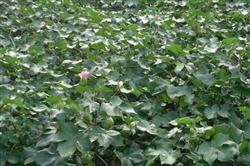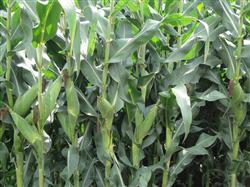Cotton planting technology: What is the main management of cotton in July?

What is the main management of cotton in July? Please introduce the main management of cotton in July as follows: (1) opening ditches to cultivate soil. It is beneficial to watering and drainage, preventing drought and waterlogging, ventilating the lower part of cotton field, reducing humidity, increasing the temperature difference between day and night, improving the microclimate of cotton field, preventing boll rot and lodging, and promoting root protection. After uncovering the plastic film in the cotton field, combined with ploughing and loosening the soil, ditching and soil cultivation should be carried out where possible, mainly by machinery and animal power, with artificial assistance. Those with intermediate ploughing foundation can be completed at one time or in two stages. The low-lying land should dredge the drainage system. (2) pruning and topping. The purpose of cotton pruning is to regulate the distribution of nutrients, improve the population structure, and finally make full use of water, fertilizer, light, gas, heat and other resources to achieve high cotton yield. The use of vegetative branches (referred to as leaf branches) should not go to extremes, either none of them will be left or none of them will go. In the cotton field with high density and no shortage of seedlings, there are basically no leaf branches, but in rare places, lack of seedlings and the edge of the ground, 1-2 strong leaf branches per plant can be left, which can increase the number of bolls per plant; it is not advisable to retain all leaf branches, and the leaf branches that have not yet appeared and whose buds are very small are resolutely removed in early July; if the leaf branches are strong and have grown fruit branches, they can beat the leaf branches immediately and can no longer let them grow. If there are too many peaches before Fuqian, it will bring many disadvantages to cotton plants, such as premature senility, stiff petals, rotten peaches and so on, so it is necessary to remove all the flowers that have bloomed at the beginning of July so that the cotton plants can save nutrients and bear more bolls when the conditions are suitable. In the cotton fields of 2500-3000 plants per mu in south-central Hebei and northwest Shandong, 13-14 fruit branches per plant should be topped in time according to soil fertility and density. Do not be afraid of shedding and greed and repeatedly postpone topping and blindly leave more fruit branches. Planting varieties with higher boll weight should seek not only higher boll number per mu, but also higher single boll weight. Do not or less early peach, late peach, will greatly improve the uniformity of cotton bolls. (3) tighten up chemical control. In general, chemical control should be 2-3 times in July, the first time in the early flowering stage, 1-1.5 grams per mu, the second time in the full flowering stage, 1-2 grams per mu, and the third time after topping, 3-5 grams per mu. As the cotton plant is larger now, chemical control should spray the whole plant with 20-25 kg of water per mu to spray the tip of the top and middle and upper fruit branches. (4) provide fertilizer in time. On the basis of applying sufficient base fertilizer, cotton generally does not need to apply quick-acting nitrogen fertilizer before blooming and setting bolls to avoid excessive vegetative body or vegetative growth; topdressing should be applied at the peak flowering stage (the fourth fruit branch blossoms), 10-15 kg urea per mu according to soil fertility and cotton plant growth; if potash fertilizer is not applied or the amount of potash fertilizer is too little, it should be applied as soon as possible. The cotton field topdressing in July can be absorbed and utilized by cotton plants on both sides of the big row. Do not apply fertilizer between small rows to avoid further damage to the originally weak root system. Every year, fertilization is too close to the cotton plant and causes wilting. For seedlings that are late due to herbicides or diseases, irrigate the plants with 1% urea water, and those that do not grow will be sprayed with gibberellin. For cotton fields with weak nutritional growth due to drought or excessive phosphorus application, urea solution should be sprayed to make the tip and fruit branch tip extend as soon as possible. After cotton topping, nutrients should be given priority to supply young bolls, foliar fertilizer should be used to ensure the nutrition of cotton plants, and foliar fertilizer should be mainly nitrogen and potassium. Urea and potassium sulfate is the best choice, fertilizer concentration 2%, each mu with fertilizer more than 1 jin, avoid spraying at noon, be sure to spray the back of cotton leaves wet. Spray immediately after topping, once every 8-10 days, first nitrogen and then potassium, can be sprayed until August 10-15. The principle of cotton topdressing is not to overdo it before flowering and not to lose fat after flowering. Once fattened, it is difficult to achieve the top of autumn peach. In the later stage, sufficient spraying of available potassium fertilizer twice is very important for bolls, bolls and bolls in the upper part, and potassium is indispensable for the development of cotton fiber, so potassium application can improve lint percentage, especially in cotton fields where water has accumulated in the years of heavy rainfall in summer. Potassium spraying is more necessary. (5) to control the disease. Fish protein and Kehuangku are good drugs to prevent cotton yellow wilt in the middle and later stage. Fish protein should be used once in early July, once every 10 days for 3 times, 50-75 ml per mu, easy to spray twice between fish proteins, so as to achieve the purpose of disease control. Cotton fields that spray fish protein do not need to be sprayed with urea. Fish protein should not be used again in August to prevent greed, but it is necessary to spray potassium twice in August. Click to get more cotton planting technology click to get more food crop planting technology
- Prev

Cotton planting technology: what is the use of potassium spraying cotton in August?
What is the use of potassium spray on cotton in August? Please introduce that in August, with the deterioration of soil permeability and the decrease of soil temperature after ridge closure, the potassium supply capacity of soil is gradually weakened. If potassium fertilizer cannot be supplemented in time, it will show obvious potassium deficiency phenomenon. Cotton potassium deficiency is the first from the lower part of the old leaves, the general vein is still...
- Next

What factors will affect the yield of corn?
What factors will affect the yield of corn? There are several reasons that will affect the yield of corn: first, the selection of seeds is not careful. To go to the formal seed management department and select the improved varieties suitable for planting in this region is the premise to achieve high yield of maize. Second, the density is too high. In order to achieve the goal of high yield, some farmers.
Related
- The first cup of black tea in spring, the flavor and history of tea gardens in Kenya, Africa
- The computer can not only choose potatoes, but also grow tea rice. AI will grow winter oolong tea champion.
- It is not only the inflated tea bitten by insects, but also engraved with the four seasons tea in Beipu.
- The Oriental Beauty Tea Festival in Zhuxian County takes the stage at the weekend to experience the plus-size feast of oil tea.
- & quot; Oriental Beauty Tea & Exploration of Emei in Hsinchu, the hometown of quot;
- The new variety of strawberry "Tainong 1" dessert is the first choice with mellow aroma. Crimson gorgeous
- History of Tea in Taiwan: from Wild Inner Mountain to Export Tea Garden
- Two types of Taiwan Oriental Beauty Black Tea won the British three-Star Award for Childhood Tea Xiang Zhang Jiaqi changed from pilot to champion tea maker.
- Banana species and varieties: the planting history of Taiwan Xianren banana and dwarf banana is long, is banana disease resistant?
- Coffee planting Technology: Qianjie Coffee from Seedling to harvesting

